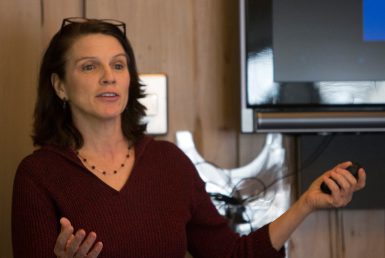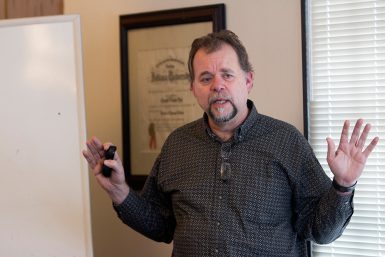Drones, data apps latest newsgathering tools

New technologies and software programs are creating new opportunities for journalists and enhancing how they present the news.
Lecturers Bonnie and Steve Layton talked about how drones, sensor technology and online visualization tools are creating new opportunities for journalists to collect and present the news during Friday’s Research Colloquium.
Steve Layton said the new tools and technology that are available increase the power of storytelling.
“It really takes storytelling beyond what we can simply do through the presentation of news,” he said.
The wealth of information that’s now available has changed the scope and potential for investigations, he said, and provides new means to generate, gather and visualize data.
Bonnie Layton said drones, sensor technology and civic hacking are new ways for journalists to generate data.
Drones are good as a tool for photography and for gathering information, she explained.
“They’re good at providing a sense of scale during a natural disaster,” she said, because a plane or satellite might not be able to capture images. She said it’s also a way for photojournalists to capture images during a large protest without putting themselves in harm’s way.

Another use for drones is to monitor change in an area, Bonnie Layton said. Matt Waite of the University of Nebraska-Lincoln launched a drone journalism lab in 2011 and used drones to show the effect of Nebraska’s drought on the Platte River.
While drones have value to the newsgathering process, Bonnie Layton said federal regulations make it difficult to use them. The Laytons have their own drone, which they showed to attendees.
“It is the most wonderful tool I cannot use right now,” she said.
The FAA has released some possible rules for using drones and they are mostly positive, Bonnie Layton said. For drones that weigh less than 55 pounds, the proposed FAA rules would require them to be registered with the agency, mandate they stay within the operator’s sight and disallow them from flying over someone not involved in the operation, according to Bonnie Layton.
Like drones, sensor technology, such as an Arduino, is a new way for journalists to gather primary information, she said. Journalists from Columbia University used the technology to measure air quality in Beijing during the Olympics and compare it against the government’s figures, and USA Today used it to look at toxic air around America’s schools.
“It allows you to measure different kinds of phenomena,” Bonnie Layton said. “You can gather a lot of data.”
Besides new technology for gathering information, Steve Layton talked about the new ways to communicate news content.
Lately, there’s been a proliferation of new tools, and they’re not only more accessible but easy to use.
“You don’t necessarily have to be a coder to use those,” he said.
He explained the differences between infographics and data visualizations. Infographics are designed to quickly inform a reader with key pieces of knowledge, he said, and data visualizations are more complex and allow users to explore the information that’s presented.
Assistant professor Gerry Lanosga said these tools create a great opportunity for journalists.
“I think it brings down the price of admission for doing relatively sophisticated journalism,” Lanosga said.

There are dozens of apps available for visualization and analysis, Lanosga said. While using the tools is easy, he said he’d encourage people who utilize them to not only learn the technical side but also develop the conceptual knowledge underlying those tools.
Master’s student Brian Harper said the interactivity available for data visualization is helpful for both journalism and media studies.
For journalism, Harper said, readers can look at an election map and click around to look at different information.
“The visualization adds a lot to that,” he said.
When it comes to academic work, Harper said a person presenting at a conference could post a visualization for attendees to look at on their computers or phones during a presentation.
“I think it’s very valuable,” he said.

